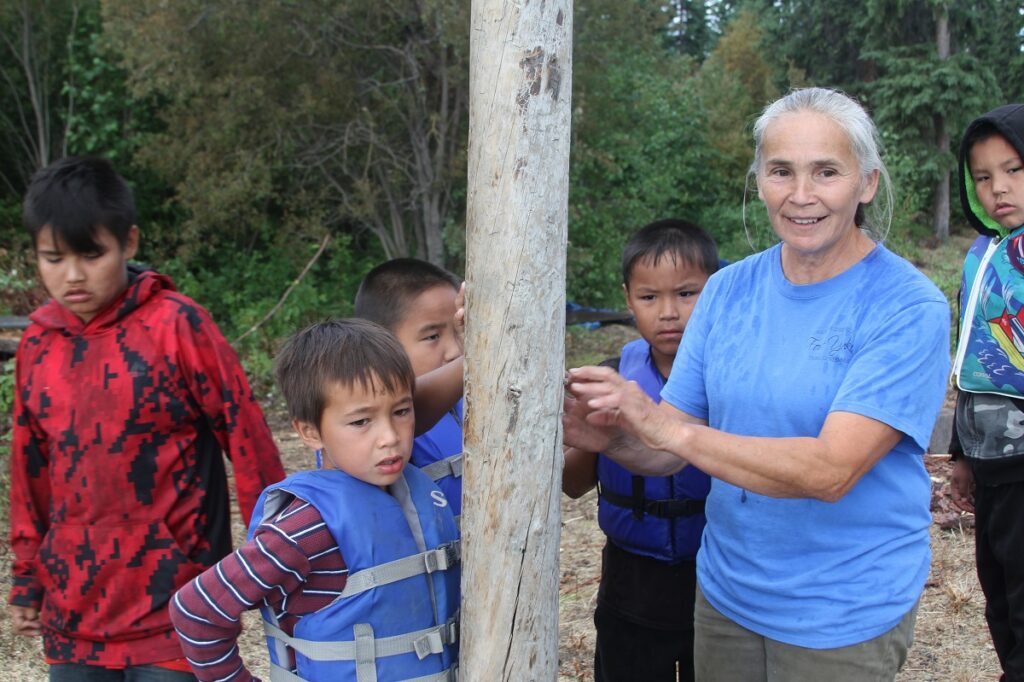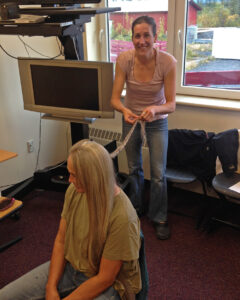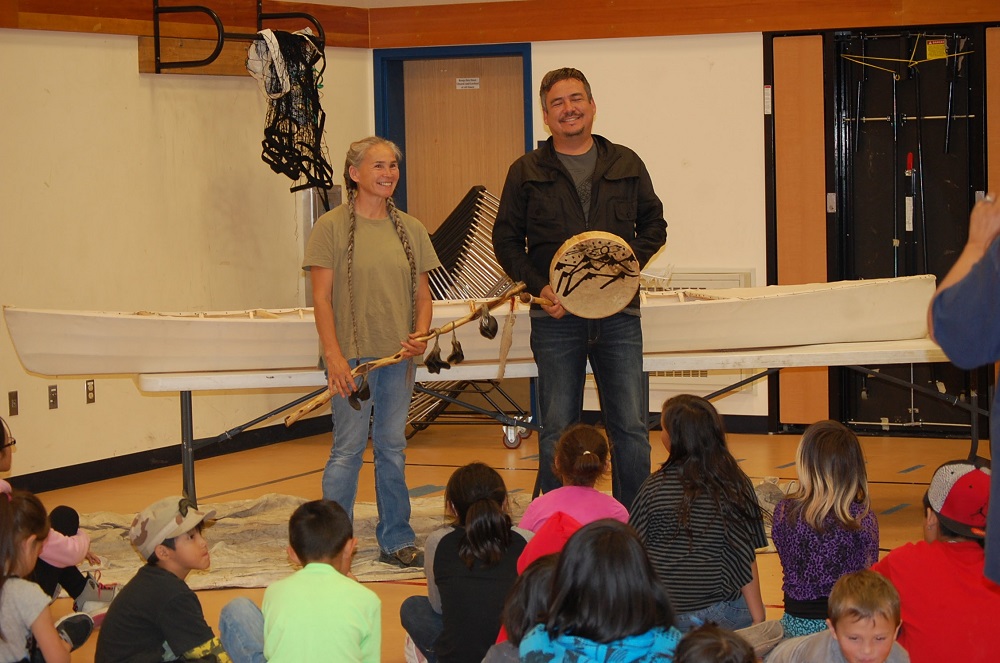Discovering myself while finding true north

Molly Rettig is the author of “Finding True North,” a journey back in time to discover what Alaska was like before the gold rush, and the ensuing resource booms that reshaped Alaska forever.
Click here for more info about how you can support the League when you purchase “Finding True North.”
By: Molly Rettig
On my third day at Gwich’in culture camp, a large black bear showed up on the gravel bar across the river. Kids came running from every direction to see. All the commotion must have startled the bear because it took off running the opposite way.
“Oh good, looks like we scared him away,” I said, watching the black rump disappear into the willows. While I love getting out in Alaska’s backcountry, I spend way too much time worrying about bear encounters. But Julie Mahler, who was leading the camp, looked disappointed.
“Maybe he’ll come back. Then I can show the kids how to shoot it and skin it,” she said.

Braiding Julie’s hair at culture camp. (Molly Rettig)
Barely 5 feet tall, with a long silver braid hanging down her back, Julie was technically an elder at 60, though she didn’t seem like one. She was running this camp to teach the local kids traditional Athabascan skills like setting nets, cutting fish and tanning muskrat skins. The long summer days were busy. While I crawled into my tent shortly after dinner, exhausted, Julie usually stayed up until midnight collecting driftwood or playing basketball with the kids.
We were staying at an old fish camp on the Porcupine River eight miles above Fort Yukon, the village where Julie had grown up. I had come to do research for a book I was writing. I wanted to examine Alaska’s resource booms through the eyes of living elders. I already had a gold miner, a bush pilot and an oil pipeline worker. Julie was going to be my trapper.
She was exactly the kind of person I had dreamed of meeting when I first came to Alaska to work at the Fairbanks Daily News-Miner. Like many idealistic twentysomethings, I had moved here with a certain image in my mind: of self-sufficient Alaskans roughing it in the wilderness. And I found plenty of them in the dip-netting, dog-mushing, dry cabin-dwelling town of Fairbanks.
But just a few years later, that image came crashing down. In 2014, the price of oil tanked, falling from $100 a barrel to between $40-60, taking Alaska’s economy down with it. The state plunged into crisis mode, slashing funding for schools and parks and health care. It toppled businesses too, closing cafes and bookstores I loved. Suddenly my job, my house and my future in Alaska all seemed at risk. Because all of it rested on one thing: the price of crude oil. Apparently, Alaskans weren’t as self-sufficient as I’d thought.

I’d met Julie soon after, while helping at a camp in Arctic Village. As we watched kids play basketball one night, she had told me about growing up in the Yukon Flats, the middle of 13 children. Her mom was a Gwich’in woman from Chalkytsik and her father was a white pilot from New York. Even though they were 100 miles from the nearest road, Fort Yukon wasn’t remote enough for Julie. As soon as she finished high school, she married Gene Mahler and moved to the bush.

Julie and Gene Mahler. (Julie Mahler)
They built a cabin on the Salmon Fork of the Black River, deep in the Arctic wilderness. Their only link to the outside world was by dog team or boat. They raised pigs, goats, horses and chickens; hunted moose, bear, rabbits and grouse. Julie set her trapline in a 25-mile loop around the cabin, selling furs for income. Once she had kids, she brought them along too, bundling them into the dogsled and stuffing furs around them like pillows. Halfway through, they would stop and camp for the night, making a lean-to and building a big fire to keep everyone warm.
Her kids grew up hunting, trapping and living off the land, and here at culture camp, that’s what she was teaching these kids too. With the continuing creep of TV and Internet, it’s getting harder to keep these traditions alive, even in rural Alaska.They built a cabin on the Salmon Fork of the Black River, deep in the Arctic wilderness. Their only link to the outside world was by dog team or boat. They raised pigs, goats, horses and chickens; hunted moose, bear, rabbits and grouse. Julie set her trapline in a 25-mile loop around the cabin, selling furs for income. Once she had kids, she brought them along too, bundling them into the dogsled and stuffing furs around them like pillows. Halfway through, they would stop and camp for the night, making a lean-to and building a big fire to keep everyone warm.
“Learning what the water can give them, what the land can give them, has value. Once they learn this stuff, they can do it themselves,” Julie said.
While we were talking by the river, Julie’s granddaughter Jewel ran up. She’s a 6-year-old reincarnation of Julie, long braid and all.
“Can we go swimming, Nana?” she asked breathlessly.
“Yes, in a minute,” Julie said.
I had one more question for Julie.
“Was it ever scary, living out there?” I asked.
She thought for a moment.
“The first time I shot a big grizzly bear, I was afraid,” she said.

Julie with young kids at their cabin on the Salmon Fork Black River. (Julie Mahler)
She was floating down this same river carrying her son, Elijah, in a blanket on her back. As they rounded a corner, a huge grizzly showed up in the main channel.
“Shoot it!” her husband yelled from the back of the boat.
“No, pull out!” Julie said.
If you’re afraid of something, you should leave it alone, her mom had taught her. But the bear was coming toward them, and she didn’t have a choice. She aimed her shotgun and took it down. As she helped Gene skin the grizzly, still wearing her son on her back, she realized something.
“That’s when I said, ‘Okay, I can handle anything.’”
As we walked down to the beach with a gaggle of kids in swimsuits, I glanced across the river again. Julie had slain a bear to prove she could live here. An actual bear! While I would never have to do that, hopefully, I did need to face my own fears: of being dependent on something I could not control. I had to find my own form of power.
Molly Rettig is the communications director at the Cold Climate Housing Research Center. She moved to Fairbanks to work as a reporter for the Fairbanks Daily News-Miner in 2010 and covered government, science and education.
Interested in learning more about the culture camps that Julie teaches at? Below is a video from the Tanana Chiefs Conference about the Youth Survivors Culture and Wellness Camp — this was from 2017 and was hosted by Fort Yukon. where youth from several communities gathered to listen to elder stories, learn Gwich’in, and practice cultural activities.
About the book, Finding True North:
Melting sea ice and rumbling volcanoes. Sled dogs racing through unnamed valleys.
These were the images that came to mind when Molly Rettig moved to Fairbanks, Alaska to work as a reporter at the local newspaper. An avid environmentalist, she couldn’t wait to explore the vast, untamed spaces that had largely been paved over on the east coast. But when her 72-year-old neighbor, Clutch, invites her on a tour of his gold mine—an 800-foot tunnel blasted into the side of his house–she begins to question many of her ideas about Alaska, and about herself.
 In Finding True North, Rettig takes us on a gripping journey through Alaska’s past that brings alive the state’s magnificent country and its quirky, larger-than-life characters. She meets a trapper who harvests all she needs from the land, a bush pilot who taught himself how to fly, and an archaeologist who helped build an oil pipeline through pristine wilderness. While she learns how airplanes, mines, and oil fields have paved the way for newcomers like herself, she also stumbles upon a bigger question: What has this quest for Alaska’s natural resources actually cost, and how much more is at stake?
In Finding True North, Rettig takes us on a gripping journey through Alaska’s past that brings alive the state’s magnificent country and its quirky, larger-than-life characters. She meets a trapper who harvests all she needs from the land, a bush pilot who taught himself how to fly, and an archaeologist who helped build an oil pipeline through pristine wilderness. While she learns how airplanes, mines, and oil fields have paved the way for newcomers like herself, she also stumbles upon a bigger question: What has this quest for Alaska’s natural resources actually cost, and how much more is at stake?
This is a book about all the ways wild places teach us about ourselves. Rettig writes both playfully and honestly about how one place can be many things to many people—and how all of it can be true.
To support Alaska Wilderness League through Amazon Smile, simply go to smile.amazon.com on your web browser or activate AmazonSmile in the Amazon Shopping app on your iOS or Android phone within the Settings or Programs & Features menu. On your web browser, you can add a bookmark to smile.amazon.com to make it even easier to return and start your shopping with AmazonSmile. On your first visit to AmazonSmile, you will be prompted to select a charitable organization to receive donations from your future eligible AmazonSmile purchases. Simply search for “Alaska Wilderness League” and hit “select”!
